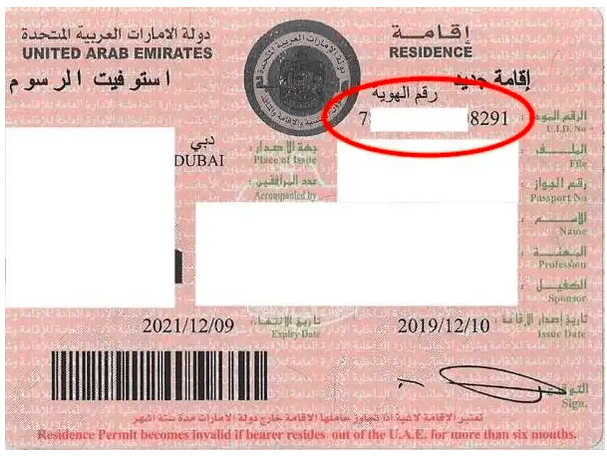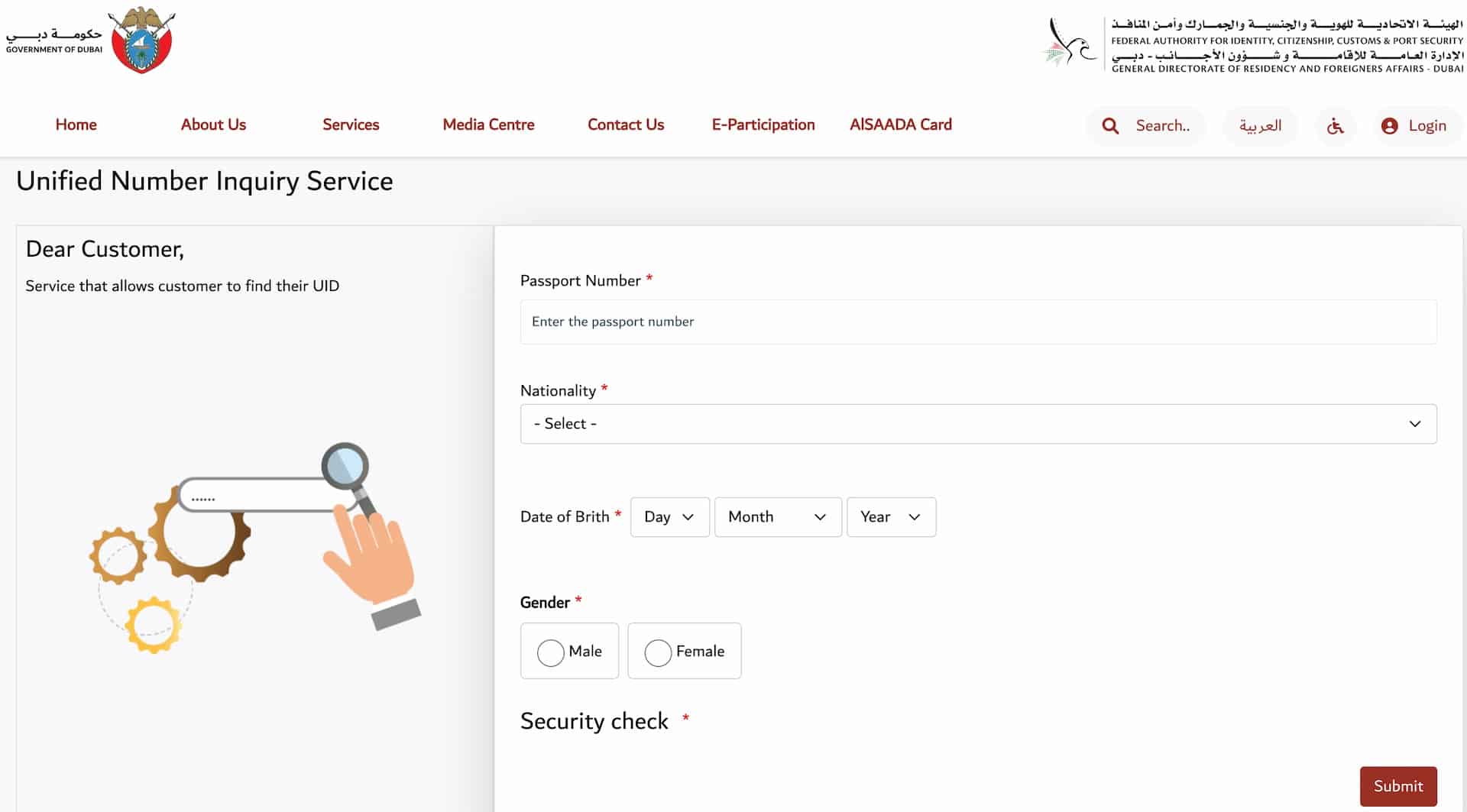Your Unified Identification Number (UID) is a vital part of your identity in the UAE. This unique number is assigned to all visitors and residents for government-related processes. Introduced to simplify and streamline immigration procedures, the UID number in the UAE has become central in managing the large number of expats who are moving to the UAE.
In this guide, we’ll explain everything you need to know about the Unified Identification Number, including its purpose, how it works, its benefits, and the steps to obtain and use it. Whether you’re a long-term resident or a newcomer to the Emirates, understanding the UID system is key to navigating life in this dynamic country.
What is a UID Number in the UAE?
The UID number is a unique 9-15 digit identifier automatically generated during the issuance of your residence visa. It is first assigned when an individual enters the UAE and is used to link all official transactions, such as visa applications, residence permits, and Emirates ID issuance. Once assigned, the UID number remains unchanged throughout an individual’s stay in the UAE, irrespective of changes in employment, sponsorship, or visa status.
The UID number is issued and managed by two main governing bodies: the General Directory of Residency and Foreign Affairs (GDRFA) and the Federal Authority for Identity and Citizenship (ICP). These organisations oversee the issuance and administration of residency permits and Emirates ID applications, among other identification processes essential for living in the UAE.
The UID number is different from the Emirates ID number, which is a separate card issued to all UAE residents, including nationals. The Emirates ID is a mandatory identification card used for various civil, legal, and service purposes across the country.
How to Find Your UID Number on Your Residence Visa
The UID number, or Unified Identification Number, is an essential part of your documentation as a tourist or expatriate in the UAE. Locating your UID number on your residence visa is simple. It is typically located right above the file number on your visa document (as shown in the below image). This number is key for identifying you in various administrative processes during your stay in the UAE.

How to Find Your UID Number Online
The General Directorate of Residency and Foreigners Affairs (GDRFA) provides a Unified Number Inquiry Service that allows individuals to retrieve their UID by entering personal information.
To find your UID number online, follow these steps:
1. Visit the GDRFA Unified Number Inquiry Service: Navigate to the official website.
2. Enter Personal Information: Provide the following details:
– Passport Number
– Nationality
– Date of Birth
– Gender
3. Complete Security Verification: Solve the security question (e.g., a simple math problem) to confirm you’re human.
4. Submit the Form: Click the “Submit” button to process your inquiry.
Upon submission, the system will display your Unified Identity Number (UID). Ensure that the information you provide matches your official documents to retrieve the correct UID.

How to Obtain a Unified Number UAE
Obtaining a Unified Identification Number (UID) in the UAE is an automatic process when you first enter the country on a residency visa. Here’s how it works:
- Enter into the UAE: When you enter the UAE on a visa that leads to residency (e.g., an employment or family sponsorship visa), immigration authorities at the port of entry (airport, seaport, or land border) issue your UID number. This number is generated as part of your immigration file.
- Visa Stamping Process: After your initial entry, you’ll undergo medical testing and apply for your Emirates ID to get your visa stamped in your passport. Your UID number in the UAE is linked to all related applications and documents during this time.
- Check Your Visa: Once your residency visa is processed and stamped in your passport, your UID number will be printed on the visa page. This number will be used consistently for all your official documents and procedures in the UAE.
- Emirates ID: When you receive your Emirates ID, your UID number will also be listed on it. The Emirates ID serves as a vital document for identification and verification across various services in the UAE.
Remember, the UID number is issued automatically so you don’t need to apply for it separately. It’s assigned to you based on your immigration and residency records. Ensuring all entry and visa processes are completed accurately helps avoid issues with your UID number assignment in the UAE.
What to Do if You Can’t Find Your UID Number in the UAE
If you don’t yet have a UID number or cannot locate it online, you can inquire directly through:
- GDRFA Contact Form: Available on their official website.
- Phone Numbers: UAE toll-free: 8005111 or International: +971 4 313 9999
- In Person: Visit the General Directorate of Residency and Foreigners Affairs (GDRFA) headquarters in Al Jaffliya, Dubai, for assistance.
What is the UID Number in the UAE Used For?
The UID number in the UAE has a wide range of applications, making it an essential part of the country’s immigration, residency, and administrative systems. Here’s how it’s commonly used:
1. Immigration and Residency Records
The UID number is a central identifier for tracking your entry and exit history, visa applications, and residency permits. It ensures that all your immigration records are accurate and consolidated under a single system.
2. Visa Applications and Renewals
The UID simplifies the visa application process for residents, families, and visitors by verifying identities and tracking application statuses. It’s also vital for processing visa renewals and extensions.
3. Emirates ID and Residency Documents
The UID is closely tied to your Emirates ID and residency documents, linking all your personal records to your official identification in the UAE. This connection ensures seamless access to government services and legal processes.
4. Access to Public Services
The UID number is indispensable for accessing public services like healthcare, education, and taxation. It helps verify eligibility and ensures fair distribution of government benefits.
5. Business Setup and Compliance
For entrepreneurs, the UID number is crucial in registering businesses, obtaining licenses, and ensuring compliance with UAE regulations. It streamlines administrative procedures, especially in free zones. Additionally, the UID facilitates business growth by enabling secure tracking of the flow of goods and services across borders, ensuring transparency and efficiency in trade operations.
6. Administrative Efficiency
By serving as a unique identifier, the UID enhances administrative efficiency, simplifying interactions with government entities and reducing delays in official processes.
7. Security and Fraud Prevention
The UID number bolsters security by complicating identity fraud and crime. It is integral to the UAE’s efforts to maintain a safe and reliable administrative system.
8. Smart City Initiatives
The UID is a key component of the UAE’s e-government and smart city initiatives, facilitating efficient governance and integration with digital infrastructure. It helps streamline services like transportation, utilities, and smart payment systems.
9. Data Accuracy and Record Management
The UID ensures that personal and immigration data are accurate and up-to-date, reducing errors and improving trust in both government and private sector interactions.
10. Government Services
The UID number is essential for streamlining interactions with government entities. Whether it’s applying for permits, accessing healthcare, or registering for other public services, the UID simplifies processes and minimises bureaucratic delays.
11. Residential and Commercial Transactions
In real estate and business sectors, the UID number plays a key role. It enables smooth property transactions and business contracts by ensuring fast, secure information transfer between parties, making these processes more efficient and reliable.
What Do the Numbers in Your UID Number Signify?
Your unified number is located above your UAE visa number. The UID number carries important information about you and the nature of your visit or intention to stay in the UAE. The UID number is not generated randomly, so let’s take a closer look at what each section of this important number means.
Emirate Code
The first three digits of your UID number identify the Emirate that issued your visa. For example, visas from Abu Dhabi start with 101, Dubai with 201, Sharjah with 301, and Ajman with 401. Notably, visas issued from Abu Dhabi or Sharjah include a forward slash following these numbers.
Year of Issue
The next four digits represent the year your visa was issued, providing a clear indicator of the visa’s issuance timeline.
Visa Number
The final 7-9 digits at the end of your UID number are actually your visa number, also referred to as your residence number. This is the part of the UID number you will typically need to use when filling out official government forms in the UAE.
How to Merge Your UID Numbers (if you have more than one)
If you find yourself with multiple UID numbers due to a system error, it’s important to address this promptly, as it can complicate the issuance of your resident visa and affect your immigration records. Fortunately, there is a straightforward solution.
The relevant immigration authority, the General Directorate of Residency and Foreigners Affairs (GDRFA), can consolidate these multiple UID numbers into a single record. This ensures that your immigration status is accurately maintained.
Follow these steps to merge your UID numbers in the UAE:
- Visit the GDRFA: Their website has contact information and directions to the nearest office.
- Bring Necessary Documents: Ensure you have copies of your passport and any entry visas (including any old, expired, or cancelled visas) that display the UID numbers needing to be merged.
- Submit a UID Merge Request: The merging process involves applying for a UID merge through the GDRFA portal or an authorised centre. You will need to provide the required documents and pay an application fee to initiate the process.
- Await Confirmation: Once submitted, the GDRFA will process your request, and you will be notified when the merge is complete.
Documents Required When Merging UID Numbers in the UAE
When applying to merge multiple UID numbers, you’ll need to provide the following documents to the General Directorate of Residency and Foreigners Affairs (GDRFA):
- Valid Passport: A copy of your current passport that matches the details in your immigration records.
- Entry Visas: Copies of any entry visas associated with the UID numbers to be merged, including old, expired, or cancelled visas.
- Emirates ID (if applicable): If you already have an Emirates ID, include a copy as part of your application.
- Application Form: Complete the UID merge request form available on the GDRFA portal or at their service centres.
- Supporting Documentation: Additional documents may be required, such as proof of identity or residency status, depending on your specific case.
Make Your Move to the UAE
Understanding your Unified Number (UID) in the UAE and how to check it is an important step in preparing for your move to the Emirates. Navigating UAE immigration rules can be complex, particularly for newcomers. If you’re planning to establish a business in Dubai, our team at Virtuzone is here to support you.
We specialise in streamlining the business formation process, ensuring every aspect of your UAE residency is handled with ease. From residence and family visas to employment visas, we offer expert assistance tailored to your needs. Our knowledgeable team is ready to answer your questions and provide valuable guidance on setting up your business in the UAE.
Effectively managing your UID number is key to a smooth transition and successful integration into life and business in the UAE. Take the next step with confidence—book a free consultation with our experts today to get started.
FAQs
What are the Benefits of the Unified Number (UID)?
Your UID number is a critically important identifying number, and it has several applications. It is used to apply for your residence visa, submit an application for your Emirates ID, and support your identity in the UAE immigration system.
Which Governing Authority Issues a Unified Number in the UAE?
The General Directorate of Residency and Foreigners Affairs (GDRFA) issues a UID number to each person moving into the UAE.
Can a Person Have Several UID Numbers?
In most circumstances, no. However, occasionally, there are system errors whereby multiple UID numbers can be mistakenly assigned to one person. If this occurs, it’s best to visit the GDRFA to have your unified numbers merged.
Is the Unified Number (UID) the Same as the Visa Number?
No, the UID number is different from the UAE visa number. Your visa number will change as your visa status changes (e.g., from a temporary permit to a residency visa). Yet, whatever changes occur with each visa you have, your UID number remains the same.
Where Can I Find My UAE Visa Number?
Your UAE visa number is embedded within the file number on your visa document. To find your UAE visa number, check the actual visa copy. It is situated above the passport number and below the UID number on the visa.
What Part of My UID Do I Need to Include for my Emirates ID Application?
The first 9 digits are required to complete your Emirates ID card application.
Does My UID Number Change Over Time in the UAE?
No, your UID number does not change. It is assigned to you upon your first entry into the UAE and remains the same, serving as a permanent reference number for all official purposes throughout your stay, regardless of changes in your visa or sponsorship status.
Is a UID Number the Same as an Emirates ID Number?
No, the UID number is used specifically for residency and immigration tracking, while the Emirates ID serves as a multi-purpose national identity card for accessing various government and private sector services.
Is it Safe to Share Your UID Number?
Your UID number in the UAE is a sensitive piece of personal information, much like your social security number in other countries. It is linked to various official records, including your immigration status, residency, and visa details. While you must provide it for legitimate and official purposes, it is best not to share it with others.
How Can the UID Number Help Businesses in the UAE?
The UID number plays a significant role in helping businesses provide better customer service. By simplifying identity verification and tracking customer interactions, the UID ensures faster and more accurate service delivery. This is particularly beneficial for sectors like banking, telecommunications, and real estate, where secure and reliable identity management is crucial.
